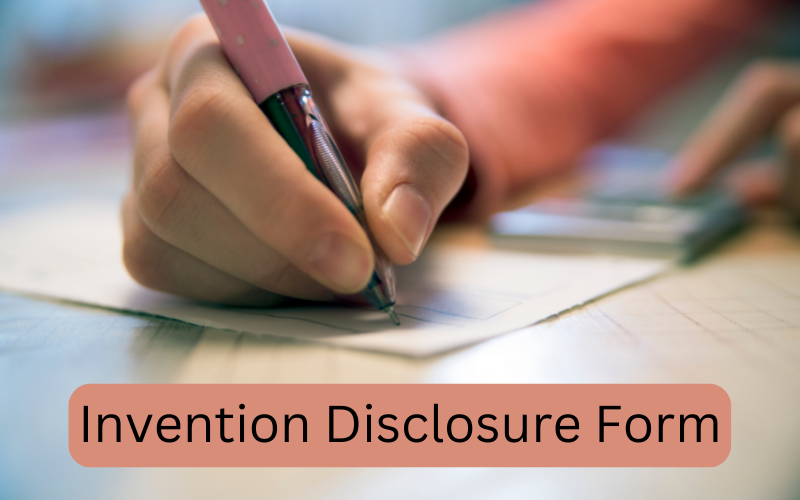What is the Invention Disclosure Form?
An “Invention Disclosure Form is basically for the documentation of the invention. This is a means to document the particulars of your invention and submit it to the patent attorney who is filing your patent application. This is the primary step in disclosing an invention.
It arranges the inventor’s thoughts about the invention. It has to be filled in a way so that your invention is apparent to the person who is unfamiliar with it. A well-written invention disclosure form enables a company to avoid non-patentable inventions.
Patent preparation from the invention disclosure form will expedite the process of preparation of the patent draft by the patent attorney.
The patent prosecution process becomes even more productive if there is a good and practical relationship between the inventor and the patent attorney. The inventor, the expert, must disclose completely with the patent attorney or agent.
Points to remember while filling out an Invention Disclosure Form:
An invention disclosure form does no “magic.” It apparently collocates the views of the inventor pertaining to his invention. It has to be filled with the utmost diligence taking care of the below-mentioned points:
1. The title should be sufficiently indicative of the subject of the invention and should reveal the specific features of the invention. It need not divulge the details of the invention and preferably not exceed fifteen words.
2. Field of the invention and use of the invention description should preferably begin with a general statement to indicate the subject matter to which the invention relates briefly. After that, the benefits of the invention can be included to clearly point out the areas of application and possible use of the invention. The applicant can also establish the industrial applicability of the invention, if any.
3. Prior art and problem to be solved should indicate the present status of the technology concerning the current developments and pending patent applications. Suppose the invention relates to an improvement on an existing product. In that case, the description should thoroughly and specifically describe the invention and precisely distinguish it from the closest prior art known to the applicant.
4. The objects/objectives of the invention part are to bring out the invention’s necessity clearly. It should distinctly mention the technical problems of current technology and the solution and decipher the distinction between the claimed invention and the prior art. The solution expected by the invention should be precisely the one used as the object(s) of the invention.
5. Most invention disclosure forms also include a summary of the invention before giving the particulars of the invention and the mode of performing it. The statement should clearly set forth the characteristic pioneering features of the invention for which protection is sought, and this part reveals different elements of the invention.
6. Detailed Description of the Invention
i) It must be furnished in adequate detail to give a complete picture of the invention and follow the invention in brief. The nature of the modifications effected should be appropriately mentioned.
ii) The particulars of the invention should be adequate for a person skilled in the art to carry out the invention. It may consist of examples, drawings, or both to correctly deduce the invention’s nature.
iii) Reference to the drawings should be appropriate.
iv) Terms in other languages used in the description, if any, must be accompanied by their English alternatives.
7. If required, drawings and/or sketches must be attached neatly on separate sheets. These must show the inventions clearly without any descriptive matter.
8. The inventor must also provide a set of keywords, which could help the Patent Attorney. These aid in finding the precise patent classification, and this also tests the patentability of the invention.
9. Claims outline the rights if and when a patent is granted for an invention. These mention the reach of the invention with brevity and exactness so that others may not trespass. Each claim is evaluated separately; therefore, it is essential to make claims on all facets of the invention.
10. References include links related to the literature and patent search. The Disclosure Form must also mention links or references similar to the invention.
11. Most invention disclosure forms also require Disclosure Information. It means the inventor has to mention the names and dates when the first disclosure about the invention happened. It is also advised to note the disclosure mode, e.g., orally or through a presentation, publication, or report. Most countries prohibit the grant of a patent in the event of any previous publication describing the invention. In such cases, the publication or public description of the invention before the patent application results in the loss of most foreign rights.
Suppose the inventor who is accomplished in that particular art provides the patent attorney with essential cooperation by giving the vital details about the invention in the Invention declaration form. In that case, it further proves to be a pivotal support to the patent counsel. The patent counsel/agent will file the patent application based on the invention disclosure form. It is the responsibility of the patent counsel/agent to prepare a complete disclosure of the invention. As a result, the patent attorney will develop the most wide-ranging claims possible without becoming an inventor.
Further, you may also be interested to read the below articles:



